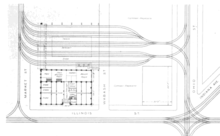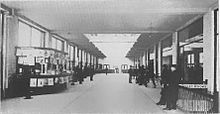Indianapolis Traction Terminal
| Indianapolis Traction Terminal | |
|---|---|
 The Indianapolis Traction Terminal in 1907 | |
 | |
| General information | |
| Status | Demolished |
| Type | Railway station |
| Address | Market & Illinois |
| Town or city | Indianapolis, Indiana |
| Country | United States |
| Coordinates | 39°46′08.25″N 86°09′38″W / 39.7689583°N 86.16056°W |
| Construction started | July 1903 |
| Completed | September 1904 |
| Demolished | April 1972 |
| Owner | Indianapolis Traction & Terminal Company |
| Design and construction | |
| Architecture firm | D. H. Burnham & Company |
| References | |
| [1][2] | |
The Indianapolis Traction Terminal was a major interurban train station in downtown Indianapolis, Indiana. It was the largest interurban station in the world and at its peak handled 500 trains per day and seven million passengers per year.[3] The station opened in 1904 and remained in use until 1941, when interurban operation ended. It continued to serve as a bus station until 1968 and was demolished in 1972. The Hilton Indianapolis now stands at its location.
Design
The terminal was designed by D. H. Burnham & Company, an architectural firm based in Chicago. The terminal consisted of three parts: a nine-story office building, a passenger waiting platform, and an adjoining train shed.
The train shed was 133 feet 9 inches (40.77 m) wide and covered nine tracks. It was positioned north-south, with trains entering from Market Street and exiting to Ohio Street. The train shed severed Wabash Street.[1]
East of the train shed was the waiting station. This consisted of a 37-foot-6-inch (11.43 m) by 137-foot (42 m) platform covered by a skylight, with waiting rooms underneath.[1]
The office building stood nine stories tall and was 163 feet 8 inches (49.89 m) by 68 feet (21 m) at its base. The building's frame was constructed with steel. The exterior of the first two stories was covered in Bedford limestone, native to Indiana, while the remaining seven stories were "speckled brick."[1]
The original complex included a freight-handling area in the northwest corner. By 1918 freight traffic outstripped the terminal's ability to handle it and the Terre Haute, Indianapolis and Eastern Traction Company constructed a separate freight station on Kentucky Avenue. All freight traffic to the terminal ended in 1924.[2]
History


The terminal was the joint effort of seven interurban railroads which provided service to Indianapolis: Indiana Traction; Indianapolis and Eastern Railway; Indianapolis and Cincinnati Traction; Indianapolis, Columbus and Southern Traction; Indianapolis and Martinville Rapid Transit; Indianapolis Coal Traction; and the Indianapolis and Northwestern Traction.[1] Construction began in July 1903 and was completed in September 1904.[2] The total cost of construction exceeded US$1,000,000.[4]: 19 It was the largest interurban station in the world.[1][5]: 69
Indianapolis stood at the center of a large interurban network; in 1914 the terminal handled 500 trains per day and seven million passengers per year.[4]: 19 Interurban service to the terminal ended in 1941 as the industry collapsed. The tracks were paved over but the terminal remained in use as a bus station until October 1968, at which time the former train shed was removed. In April 1972 the office building was demolished as well.[2] The Hilton Indianapolis, originally constructed as the headquarters of Blue Cross Blue Shield of Indiana (part of Anthem), now occupies the block.[6]
When the Terminal's train shed was torn down in 1968, it was dismantled, not demolished. The structural steel girder sections were numbered and removed to the site of the Indiana Museum of Transport and Communication (known today as the Indiana Transportation Museum) in Forest Park, located in Noblesville, Indiana. The $10,500 cost for that portion of the project was almost entirely financed (all but $500) by a donation from Ruth Lilly, and the original goal was to eventually reassemble the shed and use it to shelter the museum's existing and future railroad equipment collection. An adjoining two-story office and waiting room was envisioned, which was to include a scaled-down replica of the terminal's original waiting room.[7] However, the plan languished due to the prohibitive projected cost of its reconstruction. The stacked girders remained untouched until the early 1980s, when they were finally hauled away as scrap.[8]
The only surviving remnants of the complex today are two stone eagle sculptures that once flanked either side of the train shed. They were removed in 1968 and are now located on the steps of the Old Indianapolis City Hall.
References
- ^ a b c d e f "The New Terminal Station of the Indianapolis Traction & Terminal Co". Street Railway Review. Vol. XV, no. 1. January 15, 1905.
- ^ a b c d Marlette, Jerry (1994). "Indianapolis Traction Terminal". The Encyclopedia of Indianapolis. Bloomington: Indiana University Press. ISBN 058517685X. OCLC 48139849.
- ^ "Transportation in Indianapolis: then and now". Indianapolis Public Transportation Corporation. Archived from the original on August 26, 2014. Retrieved August 28, 2014.
- ^ a b Middleton, William D. (1961). The Interurban Era. Milwaukee, WI: Kalmbach Publishing. ISBN 978-0-89024-003-8. OCLC 4357897 – via Archive.org.
- ^ Hilton, George W. & Due, John Fitzgerald (1960). The Electric Interurban Railways in America. Stanford, CA: Stanford University Press. ISBN 978-0-8047-4014-2. OCLC 237973.
- ^ Hunter, Alan E.; Jarzen, Joseph E. (2011). Indiana's Historic National Road: The West Side, Indianapolis to Terre Haute. Images of America. Charleston, SC: Arcadia Publishing. p. 38. ISBN 978-0738588629. OCLC 746834966.
- ^ "Indianapolis Traction Terminal To Be Preserved in Noblesville". Kokomo Tribune. October 23, 1968.
- ^ Bilger, Nathan (July 21, 2010). "Indianapolis Traction Terminal". Historic indianapolis.


